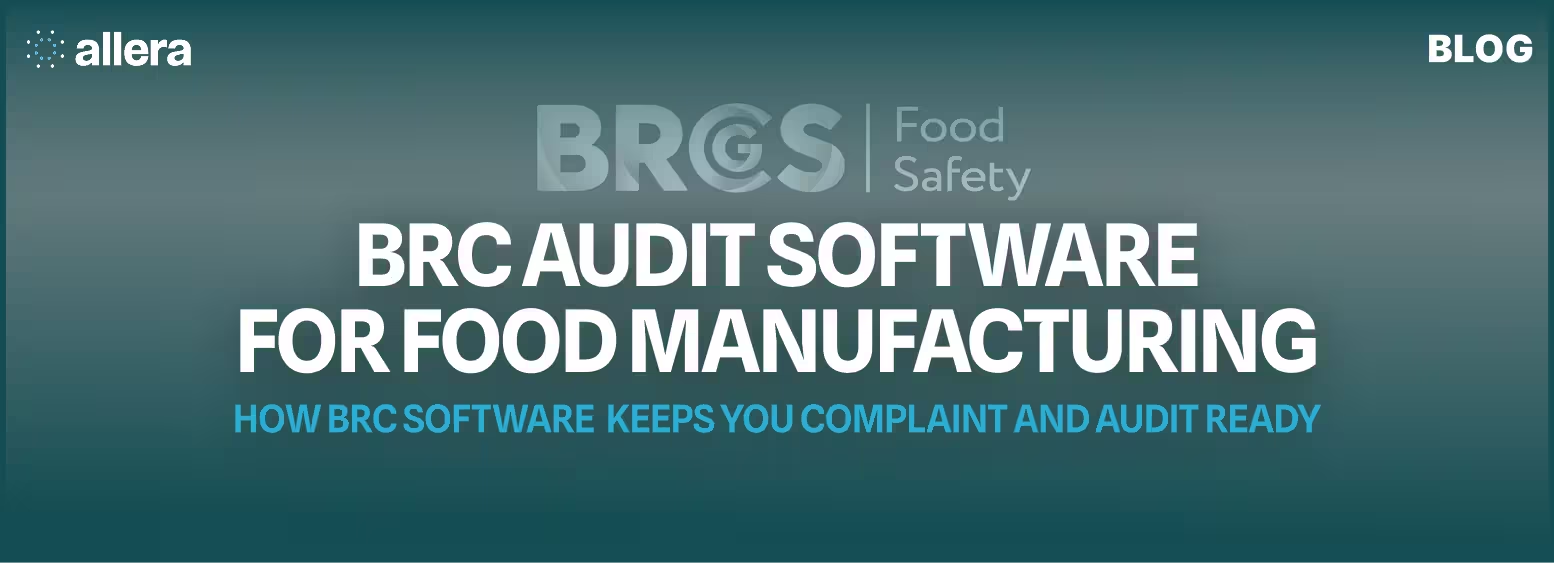

BRC Audit Software: Trusted by 500+ Food Manufacturers

Quick question before we dive in: if an auditor asked for your latest sanitation SOP right now, could you pull it up in under 10 seconds?
Key takeaways:
- BRC audit software helps you streamline inspections and reduce manual documentation work.
- Digital tools can boost traceability, which is essential for fast recalls and proving compliance.
- A tailored feature set, like real-time alerts and mobile access, can make audits less stressful.
- Planning a smooth rollout, including user training and pilot testing, helps your team adapt quickly.
- Choosing the right partner, like Allera Technologies, provides the ongoing support you need to stay audit-ready.
By the time you finish reading, you will know how BRC audit software can simplify your food safety compliance strategies. You will also discover how to navigate common issues, pinpoint the features that matter most, and map a successful adoption plan. With the right digital tool, those BRC audits that once felt daunting can become far more manageable.
What Is BRC Audit Software?
BRC audit software, also called BRCGS audit software, is a digital compliance tool that helps food manufacturers and suppliers meet the requirements of the BRCGS Global Standards. These platforms centralize documentation, streamline audits, and ensure real-time visibility into compliance performance.
Why the BRCGS Framework Matters
The BRCGS Global Standard Certification is one of the toughest benchmarks in food safety—covering hygiene, traceability, and risk controls. While it protects consumers and builds retailer trust, it also creates heavy documentation demands. That’s where audit software proves its value: turning the framework’s paperwork burden into a streamlined, digital process.
The Documentation Challenge (and How BRC Audit Software Fixes It)
Keeping up with BRC documentation can feel overwhelming. Auditors want proof of everything—temperature logs, cleaning schedules, hazard analyses, and traceability records. If you’re still relying on paper or scattered spreadsheets, staying compliant often turns into a daily scramble.
Documentation Headaches
- Hunting through binders or file cabinets when an auditor asks for a record.
- Duplicate entries across spreadsheets that don’t match up.
- Illegible handwriting or missing data on paper logs.
- Hours wasted retyping paper forms into Excel for “clean” records.
- Difficulty proving traceability when documents are scattered in different folders or drives.
- Panic during audits because critical SOPs or logs can’t be found in time.
Tip: When you’re ready to move beyond binders, Allera’s Document Control gives you version tracking, approvals, audit trails, and read-and-understand acknowledgements in one place—purpose-built for audits like BRC.
How BRC Audit Software Fix Those Headaches
After all those headaches, the question becomes: how do you make documentation faster, more accurate, and less stressful? That’s where BRC audit software steps in—with tools designed to centralize records, automate reminders, and give you real-time visibility into compliance.
Real-time visibility
Picture this: you are walking through the factory floor, and you spot a potential hazard around a production line. With digital compliance tools, you can submit your observation on the spot, tagging the location and even attaching photos. This real-time feedback loops into a centralized dashboard, ensuring that any risk can be flagged, investigated, and resolved quickly. No more waiting for weekly staff meetings or rummaging through notepads. (Allera supports digital, mobile-friendly forms across devices, making data capture simple and reliable.)
Automatic reminders and alerts
Software solutions also help you remember critical tasks. For example, you can set up automated notifications before a piece of equipment requires maintenance, or you might receive an alert if an employee forgets to record temperature checks. These reminders keep your team on schedule and remove the guesswork from compliance protocols. You will spend less time worrying about missed steps and more time optimizing your process.
Simplify audit documentation
For many QA and food safety professionals, the most time-consuming part of a BRC inspection is producing the right records, and confirming they are accurate and up to date. Imagine an auditor arriving tomorrow. Do you have the latest log of cleaning schedules? Are your HACCP (Hazard Analysis and Critical Control Point) plans updated? BRC audit software streamlines these checks, saving you hours of flipping through binders.
For a step-by-step roadmap to passing your next BRC audit, check out our blog on preparing for a BRC Audit. Inside, you’ll find a 6-month preparation checklist plus practical tips to make the process easier and less stressful.
Centralized record-keeping
A single cloud-based platform can gather every relevant file you need for an audit—preventive maintenance records, staff training logs, raw material certificates, you name it. By consolidating documentation, you can speed up your inspections and reduce the risk of missing or duplicated records. Instead of relying on memory or searching through email threads, you will have immediate access to everything the auditor may request. (This is where Allera’s Document Control shines—versioning, approvals, and a clear audit trail so you always present the right, current document.)
Keep batch/lot records easy to retrieve
In the event of a recall, minutes matter. Having digital logs of batch codes, supplier details, and distribution records helps you identify exactly which shipments might be affected. Then you can act fast, ensuring consumer safety and minimizing brand damage. To keep your fundamentals sharp, revisit FDA resources on HACCP Principles or read our food manufacturing specific HACCP principles full guide.
Log issues and track follow-ups
Even the most well-run facility will occasionally encounter complications—a temperature spike, a mislabeled ingredient, or an equipment malfunction. Modern tools let you log issues immediately, assign owners, set due dates, and attach supporting files—so follow-up is visible and documented. That means you do not have to sift through disjointed email chains or guess whether a problem was truly resolved.
Core Features of BRC Audit Software
Not every BRC audit software platform offers the same level of functionality. The best choice for your facility is one that aligns with your day-to-day compliance tasks while also keeping you audit-ready year-round. Below are the essential features to prioritize when evaluating BRC audit software:
Centralized Document Management
Keep SOPs, manuals, and training records in one secure, searchable hub. This reduces version-control issues and ensures that auditors can access the latest documentation instantly.
Customizable Checklists & Audits
Tailor inspection checklists, internal audits, and HACCP verification forms to match your facility’s exact processes. Configurable checklists ensure your team is measured against the same standards used during external audits.
Automated Workflows & Scheduling
Eliminate manual follow-ups by assigning corrective actions, scheduling recurring audits, and sending automatic notifications when tasks are overdue. This ensures accountability and reduces the risk of missed steps.
Real-Time Monitoring & Dashboards
Live compliance tracking highlights deviations before they escalate into major non-conformities. Interactive dashboards let you compare performance across shifts, lines, or facilities.
Comprehensive Reporting & Audit Trail
Generate audit-ready reports for regulators, certification bodies, or customers with a few clicks. Timestamped, tamper-proof digital records build trust and make your compliance history transparent.
Mobile Data Entry
Enable employees to log inspections, sanitation checks, and incidents directly from a tablet or smartphone. Mobile-friendly forms reduce transcription errors, speed up reporting, and keep data accurate in real time.
Custom Forms & Templates
Every facility operates differently. Flexible forms allow you to design your own inspections, incident reports, or maintenance logs—without needing developer support. Align them directly with your BRC requirements.
Secure Cloud Backup & Data Protection
A reliable BRC audit software solution should safeguard your compliance records with automatic backups and enterprise-grade security. This protects against data loss, power outages, or cyber threats while assuring auditors of document authenticity.
Tip: If these features sound like they'd add value to your food company, check out Allera’s Document Control. We provide all these benefits and more!
How to Implement BRC Audit Software?
Remember, implementing a new auditing tool is a journey, and you can make it smoother with careful planning. The second you decide to opt for BRC audit software, begin mapping your path forward.
Define Success Metrics
Measuring progress is important. Are you trying to reduce the total time spent on monthly audits? Or do you want to cut paper usage by a certain percentage? By setting clear, measurable goals, you can assess whether the tool is doing its job. Tangible results also motivate your team to embrace the system and take pride in improvements.
Start With a Pilot Group
Pick a smaller production line or a specific department to test the waters. A pilot group helps you iron out potential snags in a controlled environment. Solicit honest feedback—what did they like, what workflows need refining, and how does it stack up against your old system?
Encourage Transparency and Collaboration
Keep communication open. Let everyone know why you are introducing the software, what successes you expect, and what support is available. Invite regular feedback sessions and Q&A forums so employees can voice concerns. When team members feel heard, they are more likely to embrace the solution.
Plan for Ongoing Training
After the initial rollout, do not neglect continuous development. Software updates and BRC revisions can change how you use the tool. Hosting refresher workshops and giving employees easy access to training materials keeps everyone on the same page. This is especially helpful when you onboard new hires or expand your operation.
Maintain Momentum
Good news—once the new system starts producing results, you can build on that momentum. Celebrate small wins. Did you significantly cut the time it takes to compile an audit report? Let the team know. Positive reinforcement keeps enthusiasm high and fosters a sense of collective pride in meeting tough BRC standards.
BRC Audit Software Implementation Challenges + Solutions
Adopting new software can be exciting, but it also comes with a learning curve. You might face internal resistance, budget constraints, or the challenge of integrating new tools into an already complex environment. Here are a few concerns most food manufacturing teams encounter—and how to address them.
Staff Resistance
Change can spark anxiety. People might worry that they will lose some autonomy or fear that software will make their jobs more complicated. A good strategy is to conduct small-scale pilot programs and give employees a chance to test the software in a low-pressure environment. Gather their feedback, refine your processes, and showcase how it actually makes day-to-day tasks easier, not harder. (We’ve seen pilots help teams adopt digital forms quickly—fewer clipboards, fewer errors.)
Training Requirements
Any software is only as good as its users’ ability to handle it. You can improve adoption by offering thorough training, including brief video tutorials or step-by-step guides. Hands-on workshops can also help staff become comfortable quickly. If your software is user-friendly, team members who once struggled with reams of paperwork will often appreciate the shift. (Allera’s platform is designed to be simple for line operators and supervisors alike, with document control and mobile forms that are easy to learn.)
Integration with Existing Tools
Perhaps you already use a specific enterprise resource planning (ERP) system or a quality management solution. The best BRC audit software typically supports common imports/exports so you don’t have to start from scratch. Before committing, make sure your chosen tool can move data cleanly across systems.
Cost Worries
Budget is always a factor, especially for smaller manufacturers. However, think about the big picture. How many hours do your team members spend chasing records or rechecking data? If introducing the software can reduce prep time, streamline documentation, or help you avoid major non-conformances, it can become a cost-saver in the long run.
Conclusion: Choose a Trusted Software Partner
You have learned how a well-chosen BRC audit software can transform your compliance workflow—making daily tasks simpler, records more reliable, and audits far less nerve-wracking. But perhaps the biggest difference maker is the support and partnership you get. That is where we believe Allera stands out for food manufacturers. With document control purpose-built for audits and supplier management automation that streamlines onboarding and document collection, we help you keep evidence organized and accessible—so you’re ready when auditors arrive.
Trusted by 500+ food companies, Allera focuses on making compliance practical and fast to adopt. If you’d like to see what this looks like in the real world, explore customer stories like How Allera Cut Eden Green’s Audit Time by 75% or Wildway Automates Supplier Management with Allera. When you’re ready to modernize your BRC prep, we’re here to help you stay audit-ready—without the last-minute scramble.
FAQs
What is BRC called now?
BRC is now called BRCGS (Brand Reputation through Compliance Global Standards). The rebrand in 2019 emphasized its international scope and focus on protecting consumer trust and brand reputation.
What are BRC audits?
BRC audits are independent assessments conducted to verify that a business meets the requirements of the BRCGS Global Standards for food safety, packaging, storage, or distribution. During the audit, a third-party certification body reviews documentation, inspects facilities, interviews staff, and checks compliance with hazard controls, hygiene, traceability, and quality systems.
Is BRC the same as HACCP?
No, BRC is not the same as HACCP. HACCP (Hazard Analysis and Critical Control Points) is a methodology for identifying and controlling food safety risks, while BRCGS is a certification scheme that incorporates HACCP principles along with requirements for quality management, traceability, and regulatory compliance.
What does BRC stand for?
BRC originally stood for British Retail Consortium, the organization that created the standards in 1998. Today, the standards are managed under the BRCGS brand.
How much does it cost to get BRC certified?
The cost of BRC certification varies depending on company size, location, and the chosen certification body. On average, businesses can expect to spend $3,000 to $8,000 USD for the audit and certification, not including internal preparation or consultant fees.
What is the BRC audit scoring system?
BRC audits are graded based on the number and severity of non-conformities found. Grades include AA, A, B, C, or D, with “AA” being the highest score. A “+” may be added if the audit was unannounced. Major and critical non-conformities reduce the grade significantly and can even result in failure.
How long is a BRC certificate valid?
A BRC certificate is valid for 12 months. To maintain certification, businesses must undergo regular re-audits before the certificate expires.
How long does it take to get BRC certified?
The certification process typically takes 6–12 months, depending on the company’s current level of compliance. Businesses with strong food safety systems may complete it faster, while those with more gaps to close may take longer.
Is BRC worth it?
Yes, BRC certification is widely considered worth it. It enhances food safety, reduces recall risks, opens doors to working with major retailers and global supply chains, and builds trust with consumers. For many companies, certification is a requirement from key buyers.
What is the difference between BRC and IRC?
BRC refers to the British Retail Consortium standards for food safety and quality. IRC usually refers to the International Residential Code for building safety in construction. They are unrelated—BRC deals with food and product safety, while IRC is a building regulation code.
Is BRC mandatory?
BRC certification is not legally mandatory in most regions. However, it is often commercially mandatory, as many retailers, supermarkets, and foodservice providers require suppliers to hold BRCGS certification.
How often is a BRC audit?
BRC audits occur annually. In some cases, depending on the grade achieved, re-certification may be required every 6 months to ensure ongoing compliance.




.avif)


.avif)
.avif)

